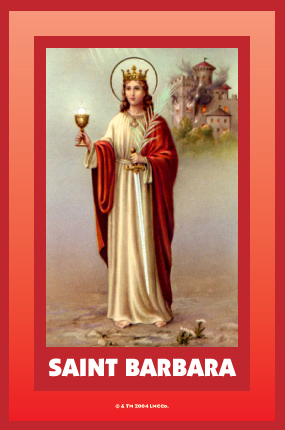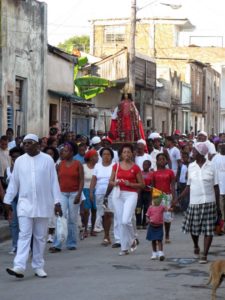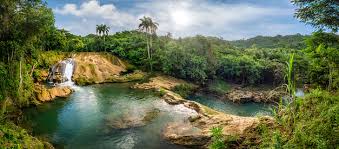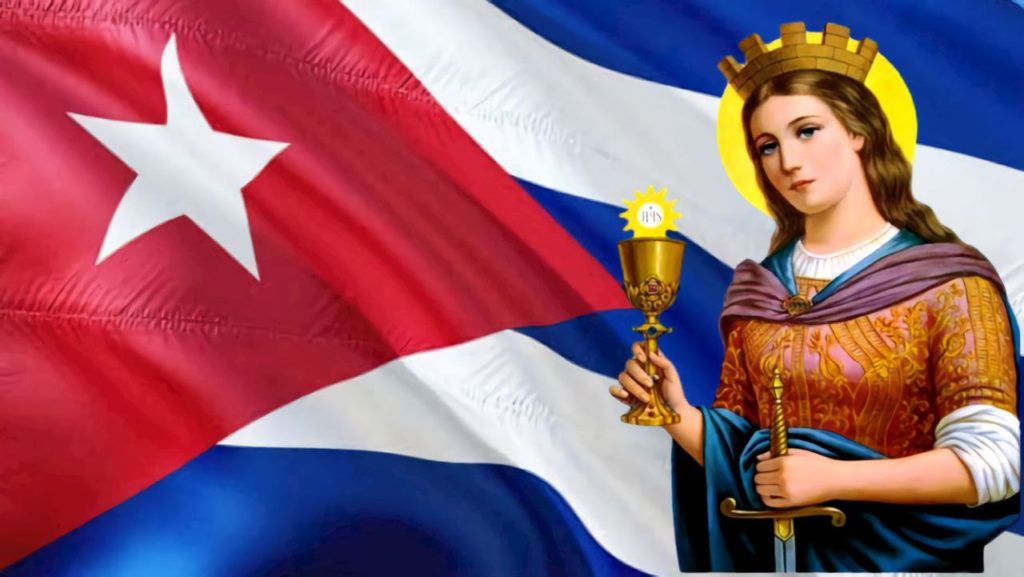LA “SANTA BARBARA” BENDITA PARA TODOS LOS CREYENTES CUBANOS. SU HISTORIA. PHOTOS
Al Igual que la Santa Virgen de la Caridad del Cobre, la bella Virgen de Regla y el consagrado San Lazaro, el viejo de las Muletas y los Perros, la imagen de Santa Barbara es una de las más veneradas en cuba.
Se le suele representar bien con la palma del martirio o bien con plumas de pavo real, pues este animal es símbolo de la resurrección o la inmortalidad, y aparece ya en la más antigua representación conocida, que data del siglo VIII en Santa María la Antigua, de Roma.
En la imagen más conocida en nuestro país suele aparecer con su atributo: una torre con tres ventanas y en otras, la torre aparece a su lado o en miniatura sobre una de sus manos. El significado de esta torre con tres ventanas es el refugio de la fe en la Santísima Trinidad. Suele llevar corona, que admite variaciones: en algunas es la de una princesa y en otras es una corona completa formada de varias torres.
La imagen de santa Bárbara también aparece a veces asociada con la espada con la cual fue decapitada por su mismo padre al negarse ella a casarse obligatoriamente y ante su conversión a la iglesia cristiana entonces, lo que ha contribuido a que sea asociada con la guerra, pero dicha espada representa un símbolo de fe inquebrantable y con un cáliz, que significa su conversión al catolicismo.
El rayo que cayó en su martirio ha hecho que sea relacionada con los explosivos y así es patrona del arma de artillería, cuyo escudo son cañones cruzados y la torre es la heráldica de los ingenieros y zapadores. El depósito de explosivos en los buques recibe el nombre de Santabárbara.
En ocasiones lleva una rama de olivo entre sus manos, representando el martirio. Pero siempre con su manto rojo, cáliz de la sangre de Cristo.
Es la patrona de las profesiones que manejan explosivos, debido a la leyenda del rayo, y especialmente de los militares que pertenecen al arma de artillería en la mayoría de los ejércitos, incluso en algunos países musulmanes. En las cuencas mineras asturianas le dedican un himno llamado “Santa Bárbara bendita”, por ser patrona de los mineros. También es la patrona de los electricistas. Igualmente es la patrona de los feriantes. Es clásico el patronazgo que ejerce de los canteros. Por ello en alguna iconografía aparece su figura junto a bloques de piedra. Es patrona también de los arquitectos.
LOS CREYENTES CUBANOS DE SANTA BARBARA Y CHANGÓ…
Los creyentes cubanos visten de rojo en su dia para honrar la historia de esta santa, fuertemente ligada al devenir y la cultura cubana. La devoción de los fieles en la isla supera incluso el culto oficial que se le oficia dentro de la iglesia católica. En ello ha influido el sincretismo con Shangó, una de las principales deidades del panteón yoruba.
Desde su decapasitión a Santa Babara se le relaciona con los estruendos y las explosiones, es la patrona de los artilleros y de los mineros. Se le ruega protección ante las tormentas y temporales, los rayos y las centellas.
De ahí proviene la máxima que advierte y reprende a quienes solo “se acuerdan de Santa Bárbara cuando truena». Atributos de Santa Bárbara Se le suele representar con la espada con la misma espada con que fuera decapitada, con un cáliz de vino, emblema de la sangre de cristo. Cuba anuncia su Certificado Digital de vacunación Igualmente, portando rayos, ramas de olivo, y una corona de rocas.
En las imágenes suele aparecer igualmente la torre donde fue encerrada por el despiadado padre. Invariablemente se hace cubrir con un manto rojo, de ahí que este color le esté dedicado entre los fieles cubanos. Changó Para los creyentes cubanos de la santería el nombre de Santa Bárbara está fuertemente ligado al de Changó, orisha de la justicia, y también de los rayos, del trueno y del fuego.
Changó es considerado uno de los orishas más importantes y fuertes del panteón Yoruba. Se considera el Rey de la Regla de Osha y sus colores son igualmente el rojo y el blanco. Cuando se habla de Santa Bárbara o Changó, casi siempre nos viene a la cabeza aquel tema imprescindible dentro de la música tradicional cubana “Que Viva Changó” que le dedicara la inolvidable Celina González.
Orisha de la justicia, la danza y la fuerza viril, dueño de los tambores Batá, Wemileres, Ilú Batá o Bembés, del baile y la música; representa la necesidad y la alegría de vivir, la intensidad de la vida, la belleza masculina, la pasión, la inteligencia y las riquezas.
A Shangó se le ofrenda amalá hecha a base de harina de maíz, leche y quimbombó, plátanos verdes, otí, plátano indio, vino tinto, maíz tostado, cebada, alpiste, etc. Se le inmolan carneros, gallos, codornices, jicotea (tortuga de río), gallina de guinea, palomas, etc. Sus ewe son el bledo punzó, atiponlá, platanillo de Cuba, Ceiba, paraíso, cedro, álamo, baría, zarzaparilla, bejuco carey, bejuco colorado, almácigo, camagua, combustera cimarrona, caña de azúcar, cebolla, caoba, flamboyán, guano blanco, guano prieto, laurel, maíz, palo amargo, mamey colorado, palo boma, hierba jicotea, piñón, piñón botija, quimbombó, rompesaragüey, ruda, tomate, travesera, yaya, palma, peonía, hierbabuena, trébol, canistel, filigrama, yaba y otros.
THE BLESSED “SANTA BARBARA” TO ALL THE CUBAN BELIEVERS. HER STORY. PHOTOS
As the Holy Virgin of Caridad del Cobre, the beautiful Virgin of Regla, and the old man with Crutches and Dogs, the consecrated San Lazaro, the image of Santa Barbara is one of the most revered in Cuba.
It is usually represented either with the palm of martyrdom or with peacock feathers, as this animal is a symbol of resurrection or immortality, and it already appears in the oldest known representation, which dates back to the 8th century in Santa María la Antigua. , from Rome.
In the most well-known image in our country, it usually appears with her attribute: a tower with three windows, and in others, the tower appears next to her or in miniature on one of her hands. The meaning of this tower with three windows is the refuge of faith in the Holy Trinity. She usually wears a crown, which admits variations: in some, it is that of a princess, and in others, it is a complete crown made up of several towers.
The image of Saint Barbara also appears sometimes associated with the sword with which she was beheaded by her own father when she refused to marry obligatorily and before her conversion to the Christian church at that time, which has contributed to its being associated with war, but said sword represents a symbol of unwavering faith and with a chalice, which means his conversion to Catholicism.
The lightning that fell in her martyrdom has made her related to explosives and thus she is patron of the artillery weapon, whose shield is crossed cannons and the tower is the heraldry of engineers and sappers. The deposit of explosives in the ships receives the name of Santabárbara.
She sometimes carries an olive branch in her hands, representing her martyrdom. But always with her red mantle, chalice of the blood of Christ.
She is the patron saint of the professions that handle explosives, due to the legend of lightning, and especially of the military who belong to the artillery weapon in most armies, even in some Muslim countries. In the Asturian mining basins she is dedicated a hymn called “Santa Bárbara Bendita”, for being the patron saint of miners. She is also the patron saint of electricians. She is also the patron saint of fairgrounds. The patronage that she exercises over the stonemasons is classic. That is why in some iconography the figure of her appears next to stone blocks. She is also the patron saint of architects.
THE CUBAN BELIEVERS OF SANTA BARBARA AND CHANGÓ…
Cuban believers wear red on her day to honor the history of this saint, strongly linked to the future and Cuban culture. The devotion of the faithful on the island exceeds even the official cult that is officiated within the Catholic Church. This has been influenced by syncretism with Shangó, one of the main deities of the Yoruba pantheon.
Since the decapitation of her to Santa Babara she is related to the rumblings and explosions, she is the patron saint of artillerymen and miners. She begs protection from storms and storms, lightning and sparks.
Hence comes the maxim that warns and reprimands those who only “remember Santa Barbara when she thunders.” Attributes of Santa Bárbara her She is usually represented with the sword with the same sword with which she was beheaded, with a chalice of wine, emblem of the blood of Christ. Cuba also announces its Digital Vaccination Certificate, carrying lightning bolts, olive branches, and a crown of rocks.
In the images, the tower where she was locked up by her ruthless father also appears. Invariably he is covered with a red cloak, hence this color is dedicated to him among the faithful Cubans. Changó For Cuban believers in Santería, the name of Santa Bárbara is strongly linked to that of Changó, the orisha of justice, and also of lightning, thunder and fire.
Changó is considered one of the most important and strongest orishas in the Yoruba pantheon. He is considered the King of Osha Rule and his colors are equally red and white. When we talk about Santa Bárbara or Changó, that essential theme within traditional Cuban music that the unforgettable Celina González “Que Viva Changó” dedicated to it almost always comes to mind.
She is the orisha of justice, dance, and virile strength, she is the owner of the Batá, Wemileres, Ilú Batá or Bembés drums, dance and music; she represents the need and joy of living, the intensity of life, masculine beauty, passion, intelligence, and riches.
Shangó is offered amalá made from corn flour, milk and okra, green bananas, otí, Indian banana, red wine, roasted corn, barley, canary seed, etc. Rams, roosters, quails, tortoises (river turtles), guinea fowl, pigeons, etc. are immolated. Its ewe are punzó bledo, atiponlá, Cuban banana, ceiba, paradise, cedar, poplar, baría, sarsaparilla, tortoiseshell bejuco, red bejuco, almácigo, camagua, maroon combustera, sugar cane, onion, mahogany, flamboyant, white guano , guano prieto, laurel, corn, palo amargo, mamey colorado, palo boma, jicotea herb, piñon, piñon botija, okra, rompsaragüey, rue, tomato, traverse, yaya, palm, peony, mint, clover, canistel, filigram, yaba and others.
Agencies/Wiki/ MemoriasCubanas/ Derubín Jacomé/ Extractos/ Excerpts/ Internet Photos/ Arnoldo Varona/ www.TheCubanHistory.com
THE CUBAN HISTORY, HOLLYWOOD.











